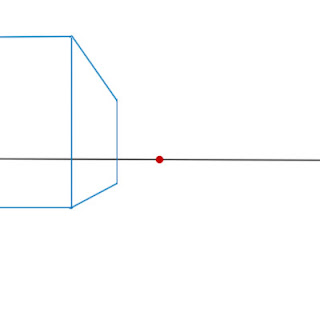
This grid illustrates the wide-angle distorted effect in one-point perspective. The squares closer to the centre look perfectly in perspective, but the squares at the very end look strangely stretched.
Art classes, and even most perspective tutorials often seem to address the Hows of perspective-drawing, but rarely the When and Why.
As it turns out, the perspective you should use (most commonly one-, two-, three-point) depends entirely lot on what you're trying to draw and the viewpoint you're viewing the scene from.
For example, if you're viewing a house from quite a close distance and only seeing two corners of the house, the situation calls for one-point perspective.

 On the other hand, if you stand back and view three corners of the house simultaneously, two-point perspective might be more appropriate.
On the other hand, if you stand back and view three corners of the house simultaneously, two-point perspective might be more appropriate.
 If the vanishing points are placed too close to each other in two-point perspective a distortion effect will become apparent. Just as in the case of the breakdown of one-point perspective in wide-angle shots, two-point perspective is also situation-based.
If the vanishing points are placed too close to each other in two-point perspective a distortion effect will become apparent. Just as in the case of the breakdown of one-point perspective in wide-angle shots, two-point perspective is also situation-based.In theory, the two vanishing points symbolizes the extreme peripheral limit of the field of view of our eye. An object which is very "large" in relation to the spacing of the vanishing points would mean that we are viewing the object from very up close. When we get too close to an object it will fill our entire field of view so that we can no longer see the it in it's entirety. I believe that's why a large object will appear distorted if it is "squeezed" into the field of view.
 In the first wide-angle example, what would seem like a simple case of one-point perspective might actually be better represented using 5-point, or curvilinear perspective.
In the first wide-angle example, what would seem like a simple case of one-point perspective might actually be better represented using 5-point, or curvilinear perspective.Tomorrow: Fish-eye view & Curvilinear perspective






No comments:
Post a Comment